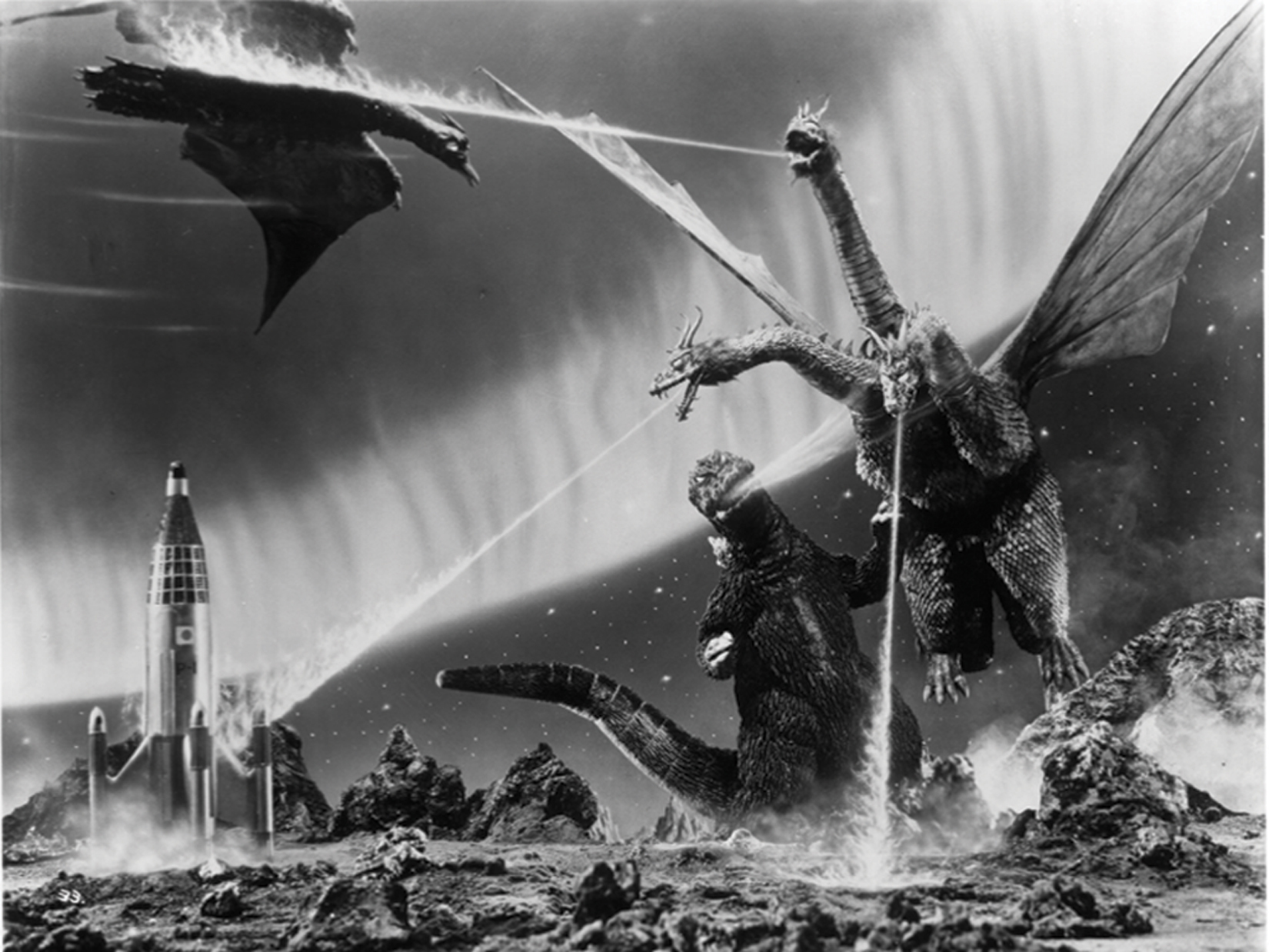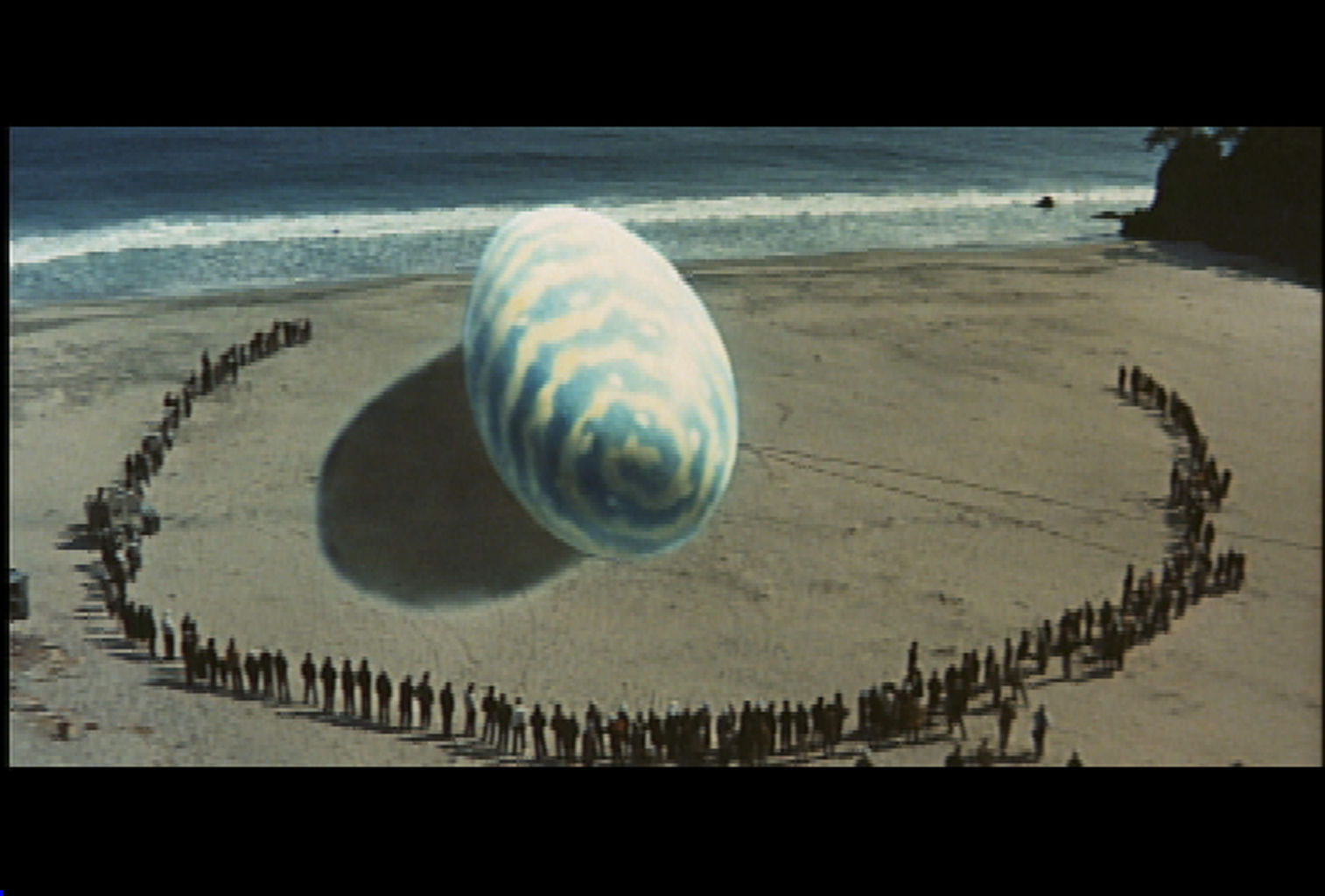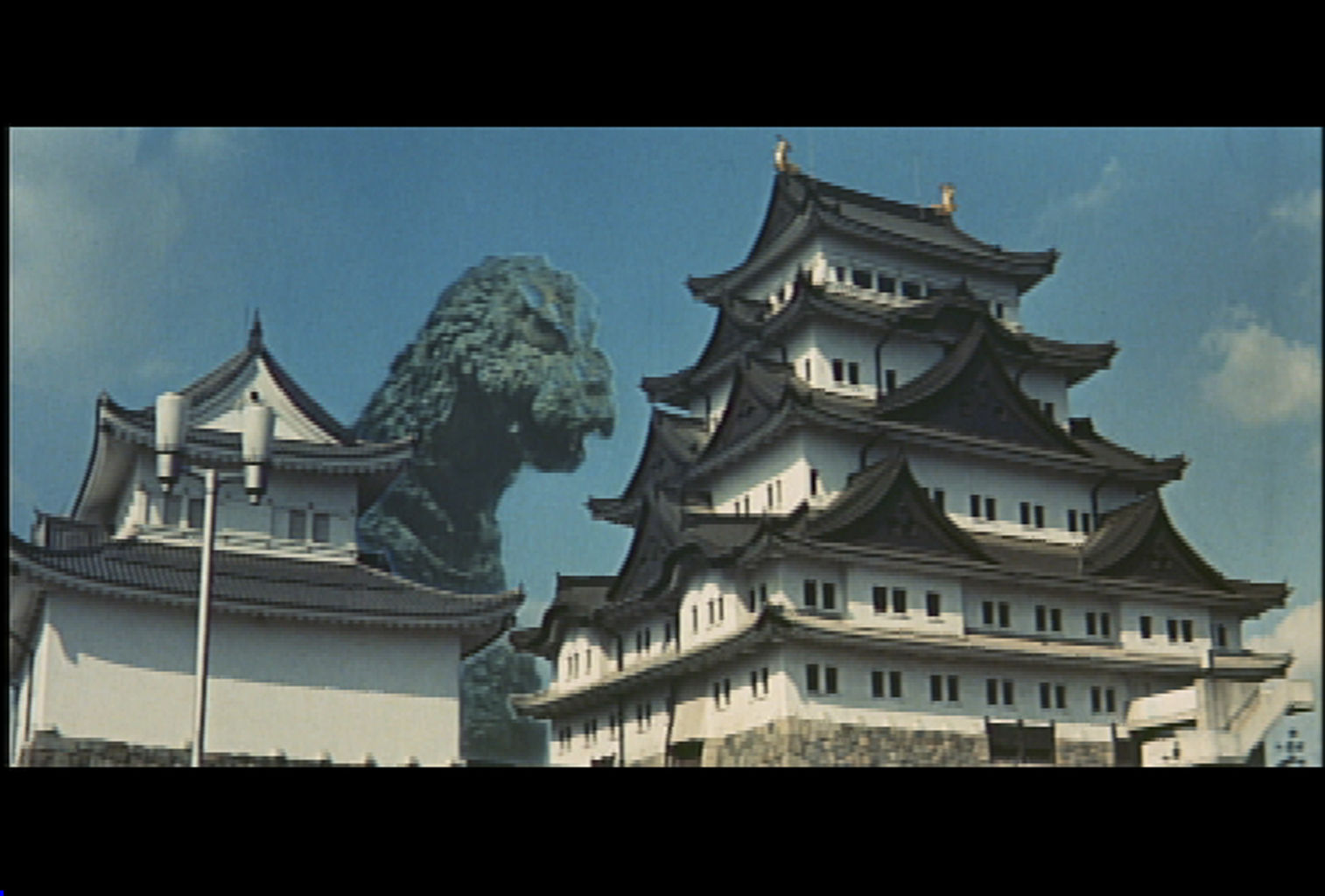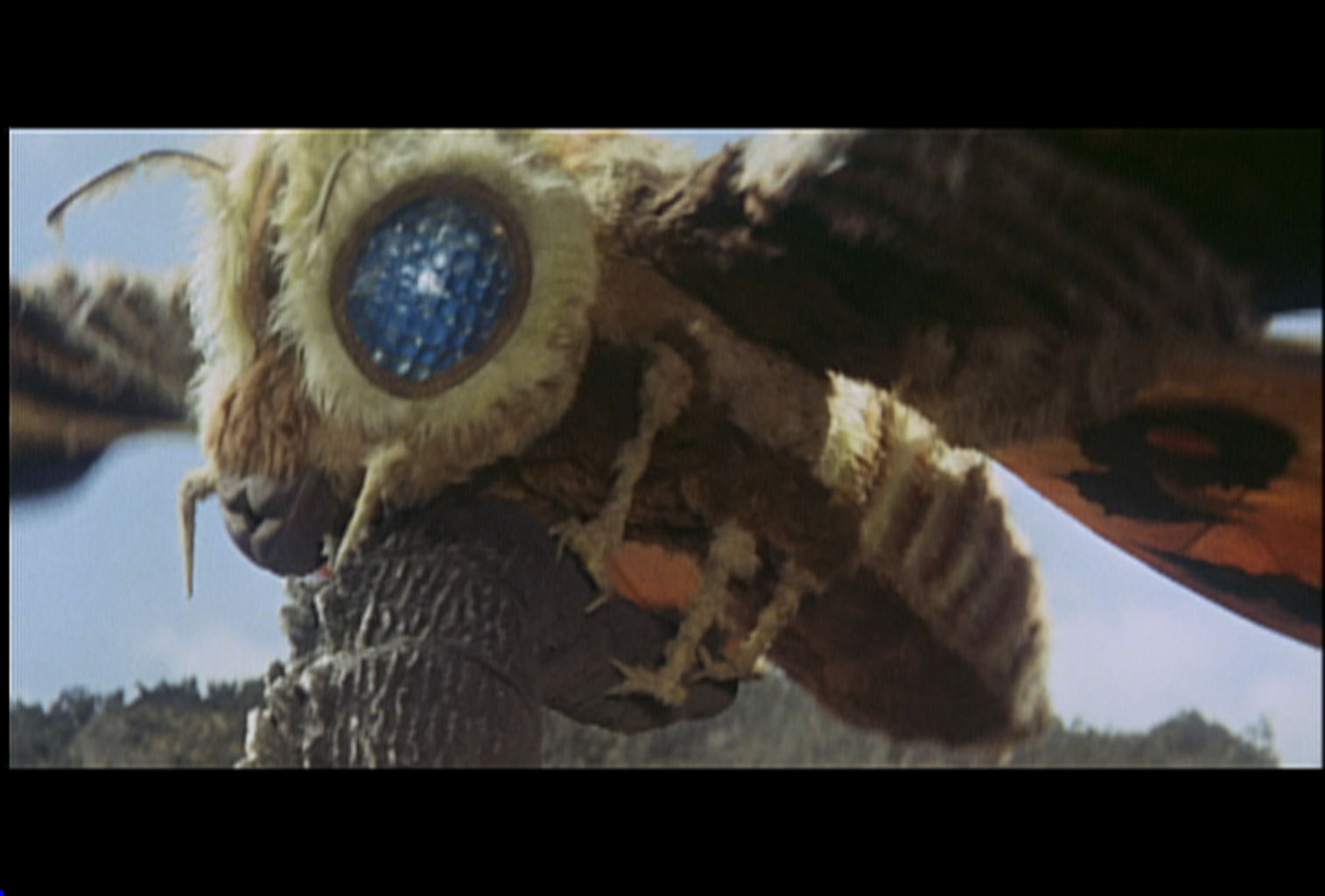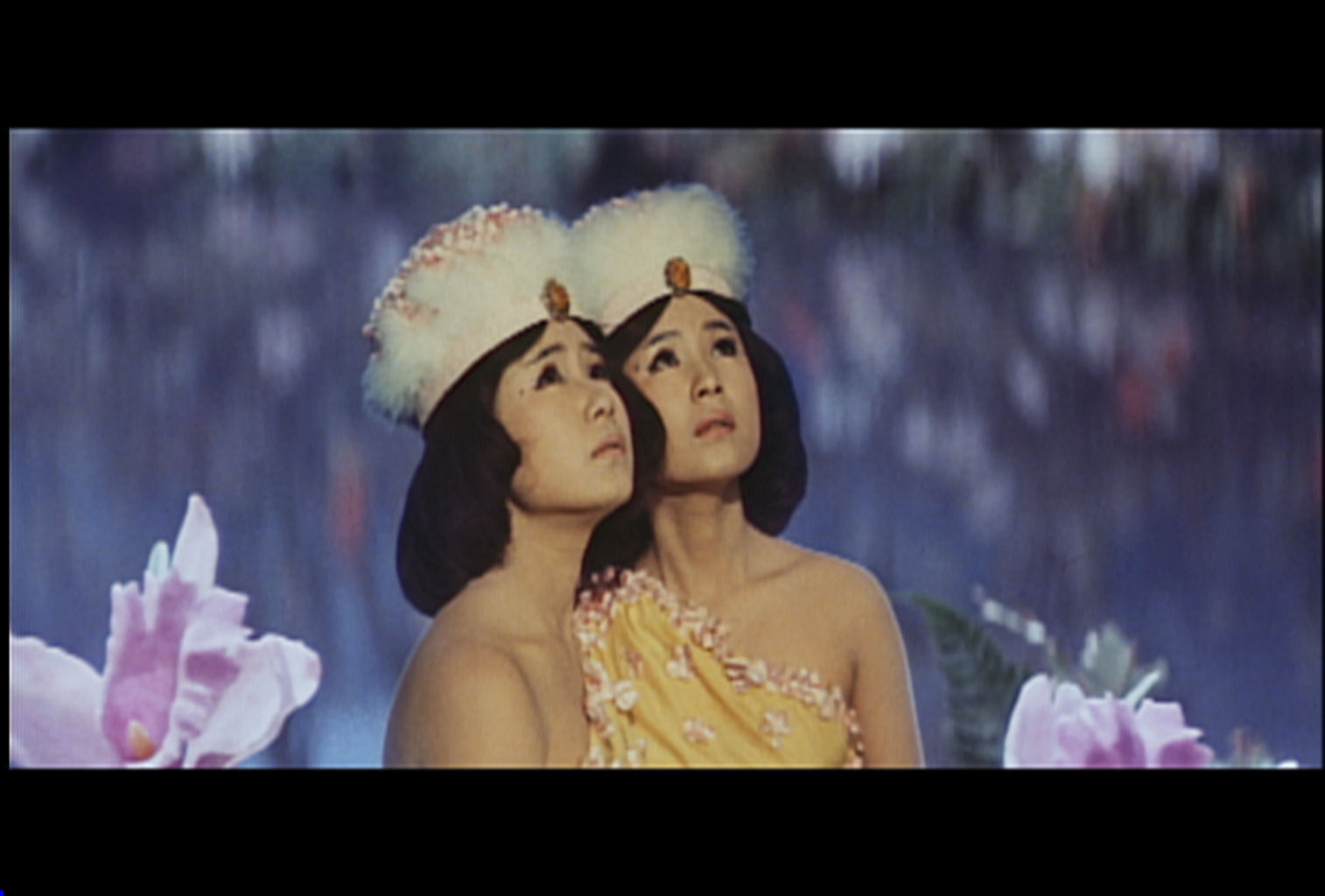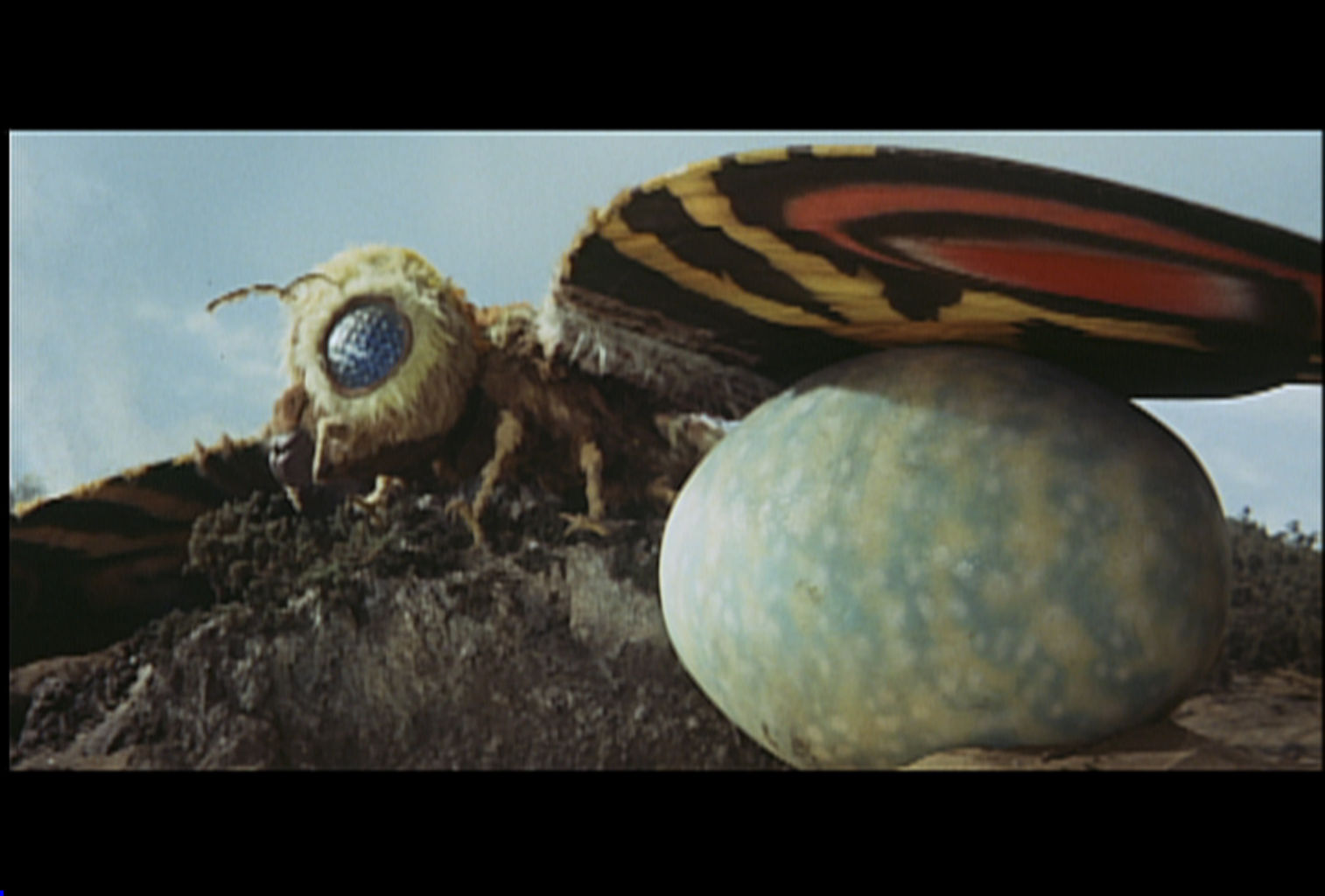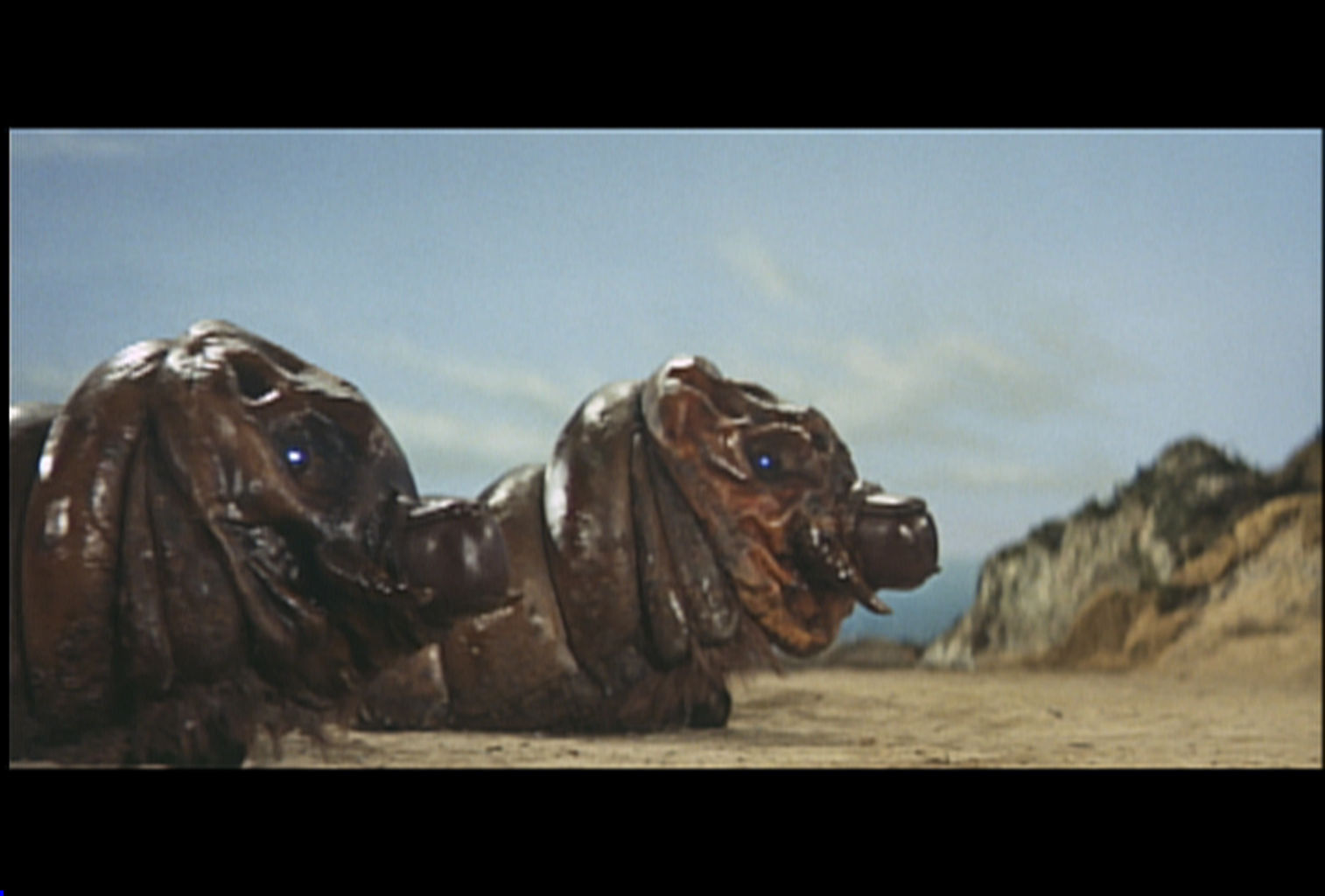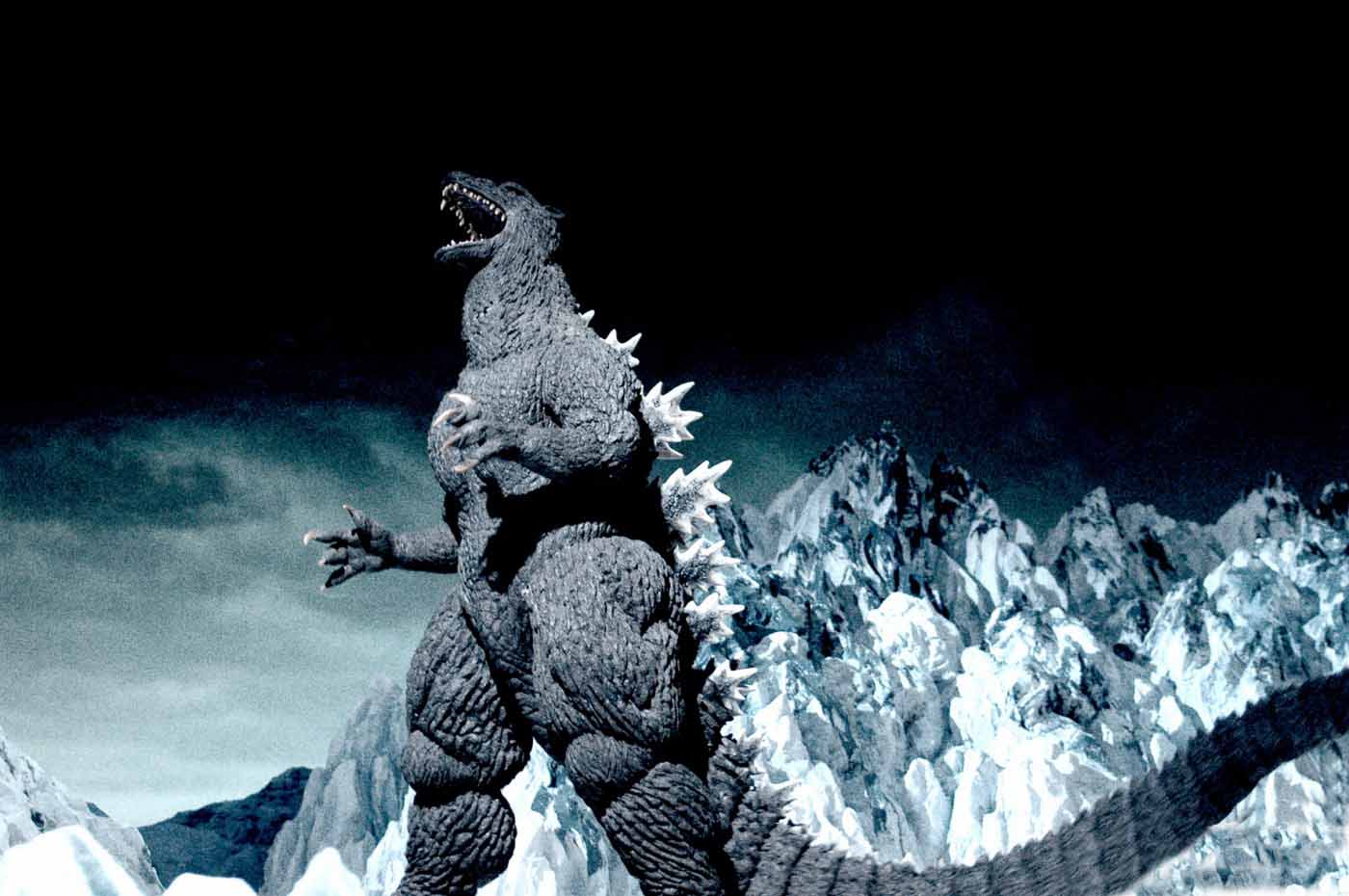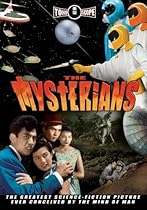 [NOTE: THE MYSTERIANS (1957) has been available on DVD for several years, but today sees it re-packaged with two other titles (VARAN and MATANGO) as part of the “Toho Triple Feature” box set. With that in mind, we offer this review of the original DVD.]
[NOTE: THE MYSTERIANS (1957) has been available on DVD for several years, but today sees it re-packaged with two other titles (VARAN and MATANGO) as part of the “Toho Triple Feature” box set. With that in mind, we offer this review of the original DVD.]
This attempt by Toho Studios to create an alien-invasion science-fiction adventure is only partially successful. The film lacks the grandeur of 1953’s lavish WAR OF THE WORLDS or even the moody tension of Ray Harryhausen’s low-budget 1954 effort EARTH VS. THE FLYING SAUCERS. Instead, we get a colorful, reasonably energetic thriller, with some sincere but slightly preachy speeches about the nations of the world learning to put aside its H-bomb arsenal and band together for the common good. (Made during the Cold War between the U.S. and the U.S.S.R., the film’s message no doubt played with much more gravity at the time.) Continue reading “The Mysterians (1957) – Film & DVD Review”
Tag: kaiju
Ghidorah, the Three-Headed Monster – Film & DVD Review
 This fifth film in the Godzilla series (following MOTHRA VS. GODZILLA) is highly regarded among fans who first saw it on television as children, but anyone looking for an awesome monster movie had best look elsewhere. By this time, the franchise had given up all pretense of serious science-fiction, opting for comic antics: this is the film in which Godzilla abandons his role as a walking metaphor for nuclear destruction and morphs from villain to hero, teaming up with fellow Earth monsters Rodan and Mothra to defeat King Ghidorah, an extra-terrestrial menace that previously eradicated all life on Venus.
This fifth film in the Godzilla series (following MOTHRA VS. GODZILLA) is highly regarded among fans who first saw it on television as children, but anyone looking for an awesome monster movie had best look elsewhere. By this time, the franchise had given up all pretense of serious science-fiction, opting for comic antics: this is the film in which Godzilla abandons his role as a walking metaphor for nuclear destruction and morphs from villain to hero, teaming up with fellow Earth monsters Rodan and Mothra to defeat King Ghidorah, an extra-terrestrial menace that previously eradicated all life on Venus.
The convoluted plot has a Japanese policeman protecting the visiting Princess Salno (Wakabayashi), who is under threat of assassination. After her plane explodes over the ocean, the Princess somehow shows up alive, now believing herself to be a prophet from Venus; she warns of the advent of King Ghidorah, a space monster that destroyed her world millennia ago.
Coincidentally, Godzilla and Rodan reappear, and the twin fairies from Mothra’s Infant Island summon their god (now in caterpillar form, since the conclusion of MOTHRA VS. GODZILLA) to convince the two rampaging reptiles to fight the three-headed dragon. (This film includes the infamous scene of Mothra, Rodan, and Godzilla literally conversing in monster language.) Meanwhile, assassins attempt to kill the Princess, who neglects to take precautionary measures because she does not remember being the Princess. Fortunately, the monsters interrupt the assassination attempts (e.g., knocking down power lines when she is about to be electrocuted), and Princess Salno regains her memory just as the final assassin is killed in a landslide caused by the monster battle, which ends with Ghidorah flying away in defeat.
Even by the waning standards of Toho monster movies, GHIDORAH is weak. Its message about cooperation in the face of a common enemy is delivered on the level of a kiddie flick. The pacing is slow, padded out with repetetive and/or unnecessary scenes. Just when the action does seem to be building to a climax, the movie inserts frustrating fade-outs reminiscent of a made-for-television film (you expect a commercial break to cover up the fact that we’re transitioning away from action we want to see).
The idea seems to have been to cross-polinate two genres: science-fiction and international intrigue. The two mix about as well as oil and water, and the screenplay’s trick of having the monster action conveniently assist the humans wears thin pretty quickly. Part of the problem is the jarring tonal shifts between the live action and the special effects. Director Ishiro Honda shows a few touches of wit early on (especially when poking fun at the amateur astronomers awaiting the arrival of a UFO – which never shows up), but he mostly plays the human action straight. Special effects director Eija Tsuburaya, on the other hand, handles the monsters like comical Muppets, with antics barely one step removed from the Three Stooges.
To be fair, if one embraces the silliness, some of it is amusing. Rodan’s shift from laughter – when Godzilla is being doused by Mothra’s silk-spinning – to consternation – when the thread is turned on him – is a juvenile laugh riot. At times, GHIDORAH does work on its own terms, as when the titular menace blasts the relatively puny Mothra caterpillar and the humans cry out in alarm; for a brief moment, the action has actual impact, above and beyond a cheap laugh.
Even taking this into consideration, the special effects have noticably degraded in this film. There are fewer process shots to combine live-action with special effects, making the monster footage seem like puppet theatre cut into the movie. Citywide destruction is kept to a minimum, in favor of staging most of the battle in rural areas. Also, this is the first Godzilla film in which there is no military effort to defeat the monsters; the humans simply stand around and watch while the monsters battle it out.
The cast of human characters is pretty colorless. The only sparks fly at the very end when Princess Salno bids farewell to her policeman-protector: their eyes express the emotions they are not allowed to voice. Other than that, GHIDORAH is a tepid affair, okay for fanatics but requiring too huge a suspension of disbelief to be regarded as much more than a campy trifle.
If GHIDORAH, THE THREE-HEADED MONSTER deserves to be remembered, it is for introducing the magnificent monster that would go on to be Godzilla’s most popular foe, appearing in no less than six subsequent G-films. (Besides Godzilla, Mothra is the only Toho monster with more on-screen appearances.) Ghidorah is presented here as a scourge of the Solar System, an uncontrollable force of destruction capable of reducing entire worlds to burnt-out desolation. Unfortunately, this concept would be abandoned in most of the monster’s subsequent appearances, in which the three-headed dragon was reduced to the status of a super weapon, controlled by advanced civilizations seeking to overpower Earth. In this, his first on-screen appearance, Ghidorah makes an indelible impression as the interplanetary destroyer of worlds; too bad the film itself fails to live up to the concept.
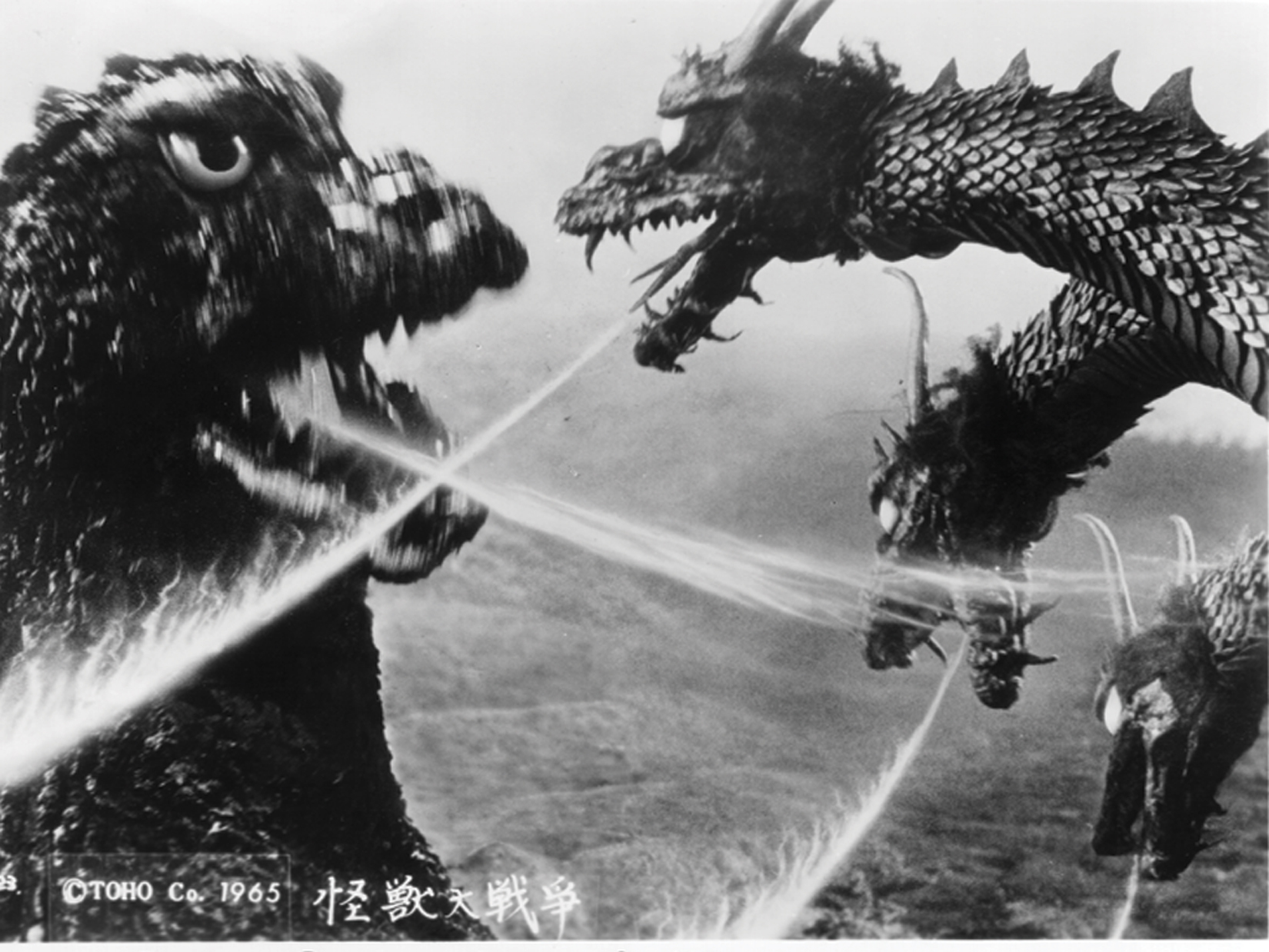
DVD DETAILS
The Toho Masters Collection DVD (ASIN: B000OCY7IU) features both the original Japanese cut of the movie, with optional subtitles, and the re-edited American version. The transfer and framing of both versions is satisfactory (unlike the same company’s MOTHRA VS GODZILLA DVD, in which the American version was badly cropped, cutting off the edges of the wide-screen photography). The color is good (better than the faded prints available for theatrical retrospective screenings), but it is not as clear and sharp as DVD releases of other Toho films from the same period.
Also on the disc are an original Japanese trailer, galleries of posters and photographs, a biography of Eiji Tsuburaya, and audio commentary by David Kalat (author of A Critical History and Filmography of Toho’s Godzilla Films).
The trailer is of mild interest because it includes a few unfinished effects scenes, such as Godzilla reacting to the lightening blasts from King Ghidorah, which have not been added to the shot yet. There are also a couple of cuts clearly showing a hand-puppet version of Godzilla that does not match the full-size suite worn by the actor.
The galleries include only a handful of posters and photographs, but unlike most DVD galleries, these contain elaborate captions that identify the images and explain their significance.
The video biography of special effects supervisor Eiji Tsuburaya is, in essence, a slide-show: comprised of still photos and narration, it does a good job of hitting the high points in Tsuburaya’s life and career; even hardcore fans, already familiar with the details, will find it interesting.
The Japanese cut of the film is approximately ten minutes longer than the American version, but in this case (unlike most of Toho’s efforts) it is not clear that the original version is superior. The longer cut moves at a slower pace, and much of the footage missing from the American version adds little to the story. In the most egregious example, the twin fairies sing not once but twice to Mothra; the second scene is virtually identical, cut for cut, to the first. The American re-edit wisely deleted the unnecessary reprise.
The American version moves along more quickly, but the re-editing introduces problems of its own. The arrival of the meteor that brings Ghidorah to Earth is moved up to the opening sequence, and the monster emerges from the meteor (in a spectacular display of pyrotechnics) much earlier. This creates an absurd situation in which Princess Salno is prophesying the arrival of a creature that has already arrived, and yet it seems to be news to the people listening to her.
Another silly bit of rejiggering leaves what looks like a gaping hole in the effects: Godzilla wades ashore, hears the sounds of Rodan flying overhead, and looks up; unfortunately, the POV shot of the clouds overhead shows no sign of the giant pteranodon – just empty sky. The glaring absence suggests that the effects team forgot to add Rodan into the shot. This turns out not to be true: in the original Japanese continuity, Rodan is first heard, then seen emerging from the clouds; after being briefly visible, he disappears back into the clouds. In the American version, the shots of Rodan have been moved up to an earlier scene of Godzilla in the ocean, implying that the sea-going dinosaur notices the flying monster and follows him to land. Reshuffling the footage creates the odd continuity gap, leaving no visible reason for Rodan’s mysterious disappearance.
The re-dubbing has its good and bad points. For some reason, Princess Salno’s Venusian prophetess becomes a Martian in the English-language version. On the negative side, giving regional accents to characters in a rural area creates Japanese characters who sound as if they wandered in from the set of FARGO. On the positive side, sound effects from the monsters were added in the background of the final gun battle between the policeman and the assassin, creating a stronger connection with the climactic monster battle taking place just over the hill.
The audio commentary by David Kalat, which plays over the American version, is a bit disappointing. Although Kalat obviously knows his stuff, he seems too eager to retract statements he made in his book (about the preferability of subtitling to dubbing) while mounting a case for the superiority of the American re-edit, and he is equally eager to downplay the flaws in GHIDORAH, THE THREE-HEADED MONSTER, both in the original version and in the English-dubbing.
Fortunately, Kalat’s formidable analytical skills have not completely abandoned him, and when he gets off his pro-dubbing soap box he does have interesting observations to make. Most notably, GHIDORAH, THE THREE-HEADED MONSTER represents a considerable advance for female characters in the series, who take a more active role in solving the problem, instead of waiting around for the men to rescue them. Kalat also points out that Princess Salno is at her most assertive when she has abandoned her royal garb in favor of a male fisherman’s hat and coat. When her rescuers put her back into female clothing, her assertiveness begins to recede, until by the end of the film she is back in her former role.
The Toho Masters DVD of GHIDORAH, THE THREE-HEADED MONSTER does a good job of presenting this historically important (if over-rated) entry in the Godzilla series. For many American viewers, this is the first opportunity to see the original Japanese version of the film, which in and of itself makes the disc worth a rental. It is also nice to have the American dub preserved for comparison purposes. But neither the quality of the film, nor of the DVD bonus features, is enough to make this an essential part of a sci-fi fan’s collection. Owning this one is strictly for hardcore fanatics and completists.
TRIVIA
When first released in the United States, the title of the film was spelled GHIDRAH, THE THREE-HEADED MONSTER, making the monster’s name only two syllables instead of three. As David Kalat points out in his DVD audio commentary, the Japanese language is spelled in such a way that two consonant sounds cannot be contiguous; a correct rendering of the original Japanese spelling produces the revised title GHIDORAH. (Although the spelling and pronunciation may have varied slightly over the years, Ghidorah’s subsequent film appearances utilized a three-syllable version of the name.)
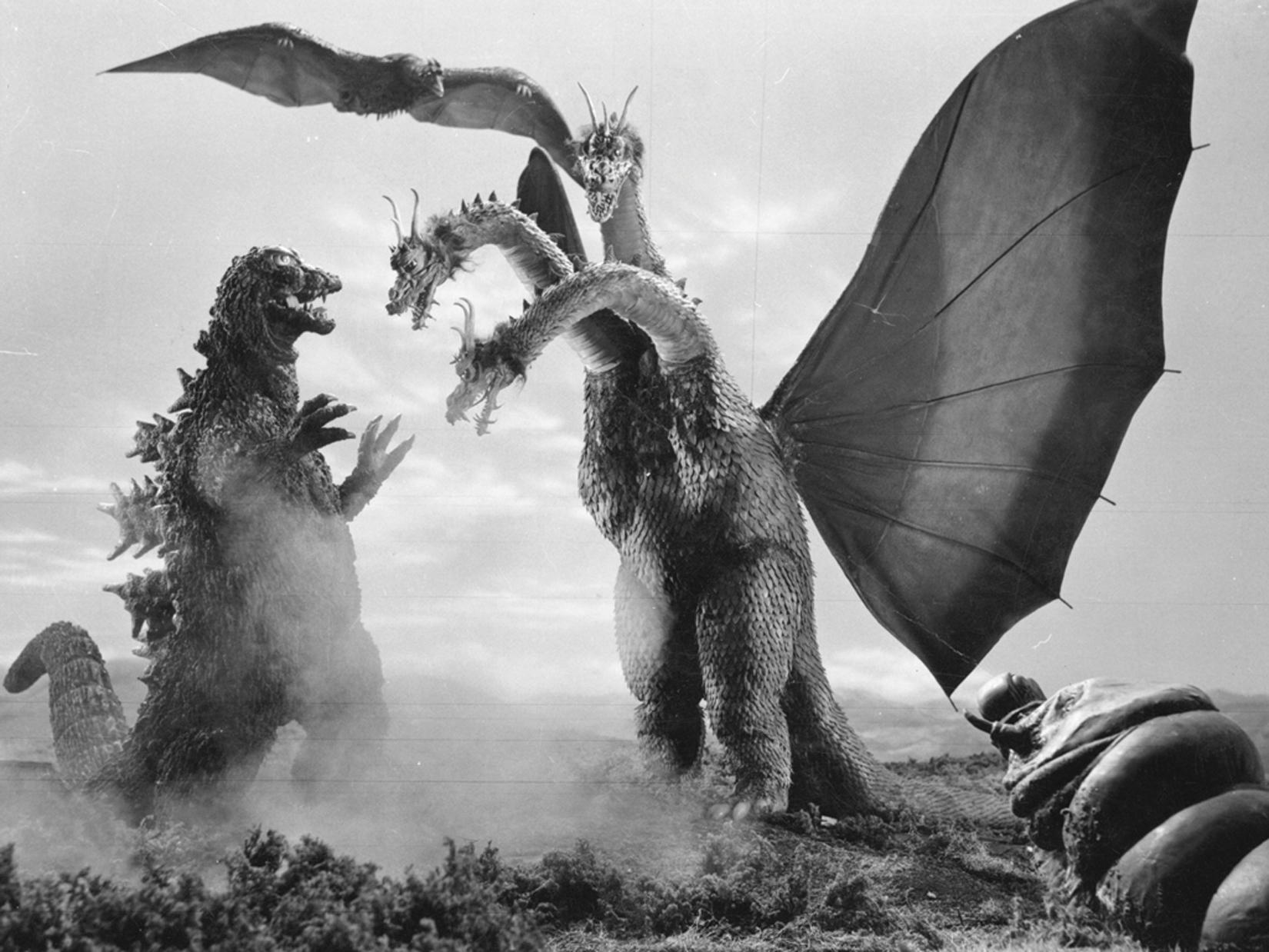
GHIDORAH, THE THREE-HEADED MONSTER (a.k.a. San Daikaiju: Chikyu Saidai No Kessen [“Three Giant Monsters: Earth’s Greatest Battle”], 1964). Directed by Ishiro Honda. Written by Shinichi Sekizawa. Cast: Yosuke Natsuki, Huniko Hoshi, Hiroshi Koizumi, Akiko Wakabayashi, Emi Ito, Yumi Ito, Takashi Shimura, Akihiko Hirata, Hisaya Ito, Minoru Takada, Sensho Matsumoto.
Invasion of Astro-Monster – Film & DVD Review
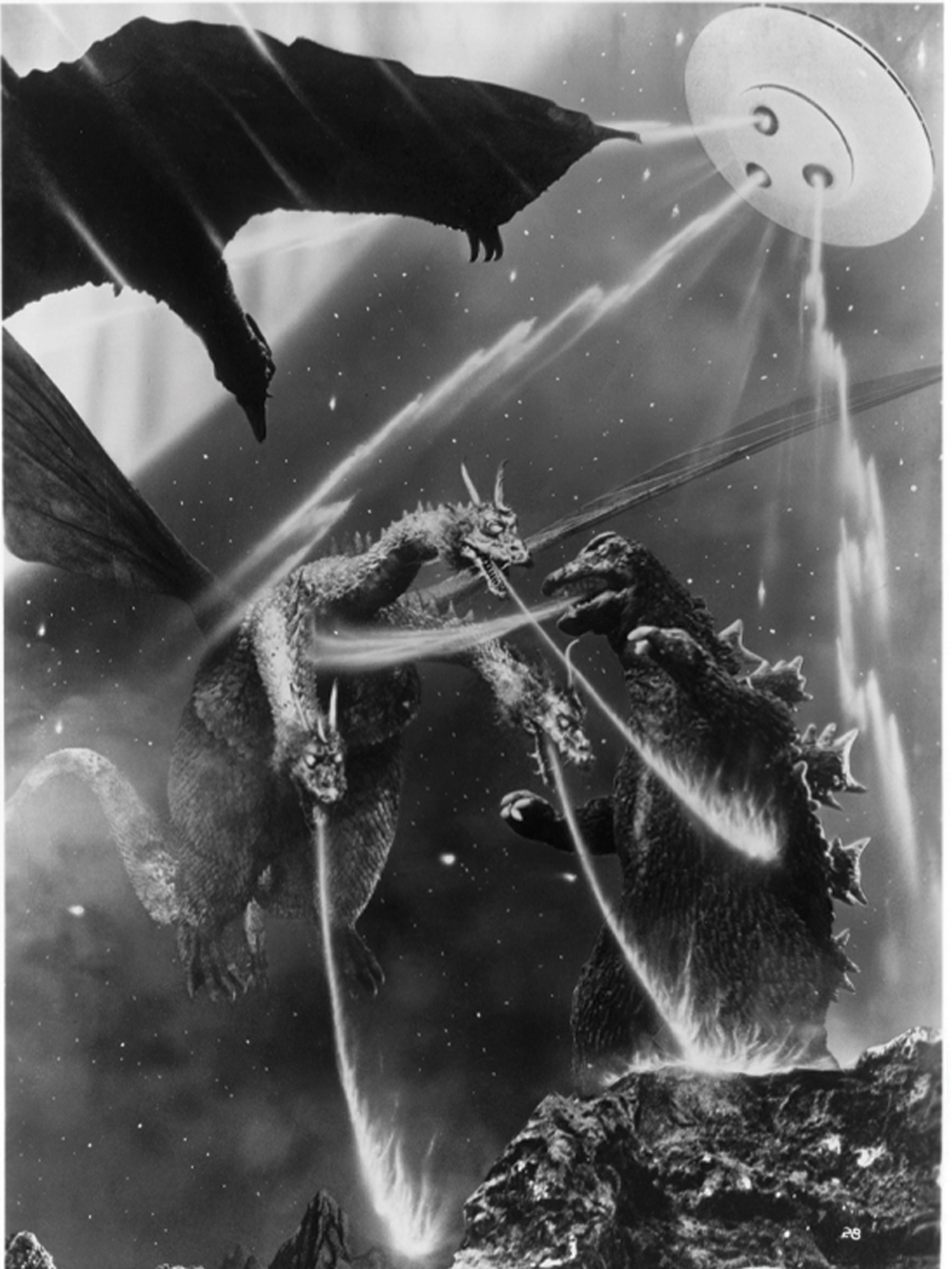 This sequel to GHIDORAH, THE THREE-HEADED MONSTER is one of the best entries in the long-running series of Godzilla films from Japan’s Toho Studios. Although the serious tone of the original GODZILLA (a.k.a. GOJIRA, 1954) were long gone, INVASION OF ASTRO MONSTER (originally released in the U.S. as MONSTER ZERO) stands out as a colorful, fun, and exciting romp of a movie. The special effects are spectacular if not altogether convincing; the action is outrageous; the story is fast-paced. And best of all there is some genuinely charming character interaction, thanks in large part to the presence of American co-star Nick Adams, who has wonderful chemsistry with Japanese star Akira Takarada and generates firey romantic sparks with leading lady Kumi Mizuno. The plot has the inhabitants of the newly discovered Planet X requesting help from Earth: the loan of the monsters Godzilla and Rodan to defeat the interplanetar menace Ghidorah, known on Planet X as “Monster Zero.” The duplicitous X-ians then double-cross Earth, demanding that it submit to Planet X or else face the wrath of all three monstes, whom the X-ians control with radio waves. This leads to a frantic effort by Earth’s forces to destroy the X-ians control of the monsters and drive the invaders from our planet.
This sequel to GHIDORAH, THE THREE-HEADED MONSTER is one of the best entries in the long-running series of Godzilla films from Japan’s Toho Studios. Although the serious tone of the original GODZILLA (a.k.a. GOJIRA, 1954) were long gone, INVASION OF ASTRO MONSTER (originally released in the U.S. as MONSTER ZERO) stands out as a colorful, fun, and exciting romp of a movie. The special effects are spectacular if not altogether convincing; the action is outrageous; the story is fast-paced. And best of all there is some genuinely charming character interaction, thanks in large part to the presence of American co-star Nick Adams, who has wonderful chemsistry with Japanese star Akira Takarada and generates firey romantic sparks with leading lady Kumi Mizuno. The plot has the inhabitants of the newly discovered Planet X requesting help from Earth: the loan of the monsters Godzilla and Rodan to defeat the interplanetar menace Ghidorah, known on Planet X as “Monster Zero.” The duplicitous X-ians then double-cross Earth, demanding that it submit to Planet X or else face the wrath of all three monstes, whom the X-ians control with radio waves. This leads to a frantic effort by Earth’s forces to destroy the X-ians control of the monsters and drive the invaders from our planet.
MONSTER ZERO is atypical for the Godzilla series in that the monsters play a subordinate role, with most of the screen time devoted to the human characters and their conflict with Planet X. Except for a couple of brief skirmishes, Godzilla, Rodan, and Ghidorah barely appear in the first half; the film saves them for the climactic battle at the end. This approach bears some fruit: with fewer scenes to work on, the special effects crew seems to do a better job, although, unfortunately, some stock footage is used (from RODAN and MOTHRA) to augment the miniature destruction scenes.
TRIVIA
The film’s original Japanes title “Kaiju Daisenso” translates as “Giant Monster War.” “Invasion of Astro Monster” was the “International Release” title used when Toho sold the film overseas. In the U.S., the film was released to theatres in 1970 (on a double bill with WAR OF THE GARGAUNTUAS) as MONSTER ZERO. For later release on VHS, laserdisc, and DVD, the title was expanded in the box artwork to GODZILLA VS. MONSTER ZERO.
The Toho Masters Collection box artwork uses the International release title “Invasion of Astro Monster,” but the English subtitles for the Japanese version of the film translate the title as “Invasion of the Astro-Monster” (an understandable discrepancy, as the Japanese language does not contian articles like “a,” “an,” and “the,” so translators must insert them at their own discretion). The English-language version of the film on the DVD retains the old U.S. title MONSTER ZERO.
MONSTER ZERO is one of the first Godzilla films to reach U.S. shores with only minor editorial alterations for U.S. release (besides the English-dubbing, of course). The opening credits substituted an eerie, ominous theme in place of the original’s rousing military march (a common element in scores by series stalwart Akira Ifukube). Some Japanese language writing and newspaper headlines were changed to English. And the Controller of Planet X is no longer heard speaking in his native tongue. Toho prepared an English-dubbed version of INVASION OF ASTRO MONSTER that retains these missing pieces, plus a brief shot featuring the original sound recorded on set, pre-dubbing, so that you hear Akira Takarada speaking in Japanese while Nick Adams responds in English
DVD DETAILS
The Toho Masters Collection DVD (ASIN: B000OCY7IK) offers the original Japanese version of the film, with optional subtitles, under its international release title INVASION OF ASTRO MONSTER, plus The Americanized English-language version, known as MONSTER ZERO. Also included are:
- A Japanese trailer
- A small but impressive poster gallery and a still photograph gallery, both with informative captions
- A video biography (using still photos and narration) of Godzilla producer Tomoyuki Tanaka
- An audio commentary by Stuart Galbraith IV, author of Monsters Are Attacking Tokyo.
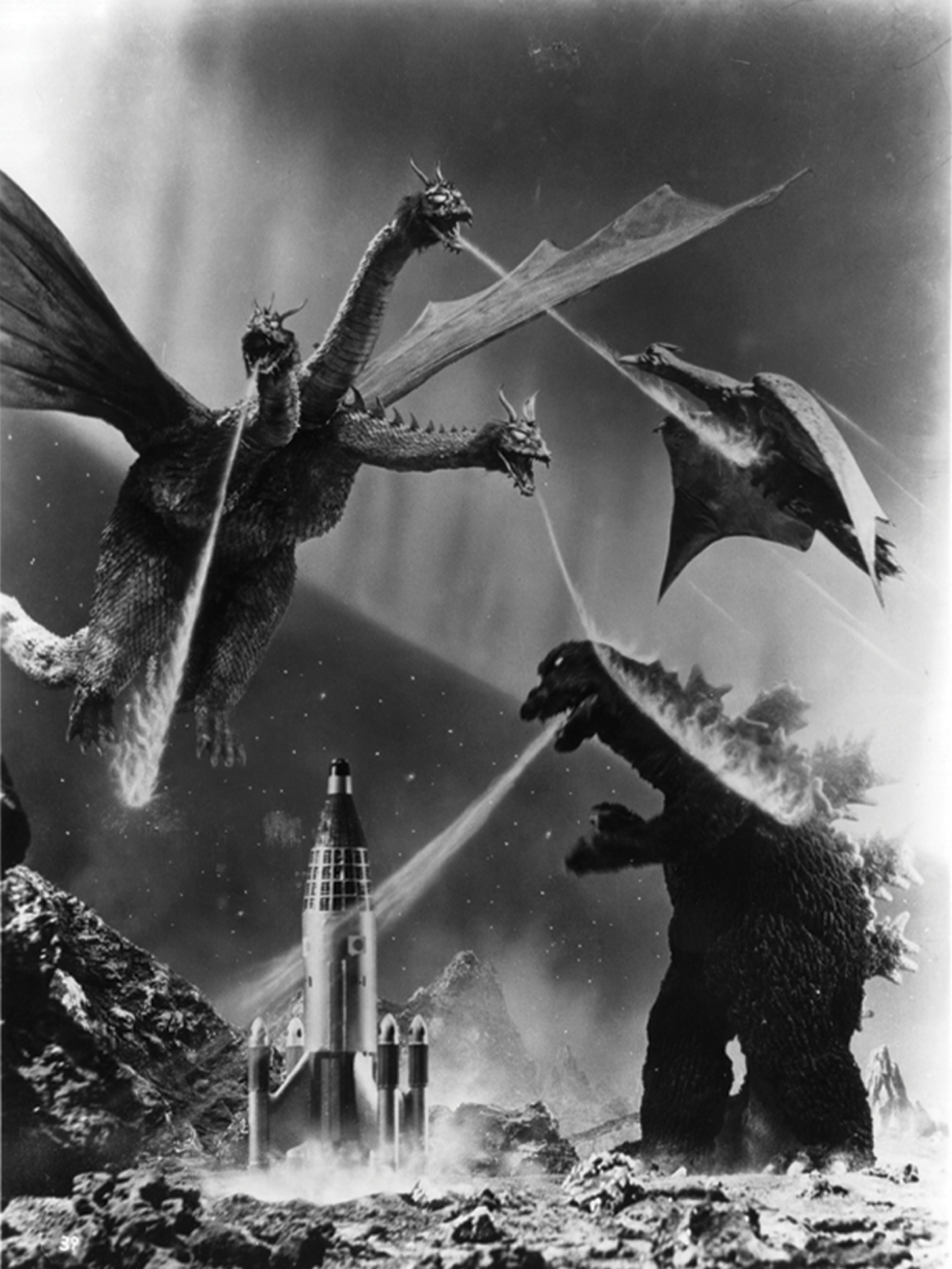 Like the other Toho Masters DVDs, this one comes in a shiny, hard DVD case with a colorful Japanese poster on the front and a nice black-and-white still photograph on the inside front cover.
Like the other Toho Masters DVDs, this one comes in a shiny, hard DVD case with a colorful Japanese poster on the front and a nice black-and-white still photograph on the inside front cover.
The transfers for both version of the film offer a clear colorful widescreen image with good sound. In general the picture quality is comparable with the out-of-print Scimitar DVD from the 1990s.
There is a slight improvement in that the Toho Masters disc has a few more chapter stops, but as with the Scimitar DVD, the chapter stops do not do a much improved job of helping you jump to your favorite moments. For example, both DVDs have a chapter stop for the three-way battle on Planet X that begins with a boat arriving at an island on Earth, followed by an extensive dialogue scene, before finally shifting to outer space for the promised action.
The trailers offers a nice glimpse of what filming must have been like. Edited together before the film had been dubbed, the trailer includes live sound takes from the filming, with American star Nick Adams speaking English to his Japanese co-stars, who respond in their native language.
The image galleries are small but impressive. Unlike most DVD galleries, these feature informative captions that induce you to actually stop and look at each individual image, instead of thumbing through all of them without pause. The information for the posters is especially useful, because the film was released several times: in Japan, in American, then in Japan again (in an edited form as part of a series of kiddie matinees called the “Champtionship Festival”). It’s nice to have the different art work identified according to which campaign it supported.
The video biography of Tanaka is on par with biographies on other Toho Masters DVDs: it’s reasonably informative, provides some interesting background details, and hits the high marks in the producer’s career. Long-time fans may not learn much new, but they will find it interesting.
Unfortunately, Gailbraith’s audio commentary is a disappointment. Although thoroughly well-versed in the subject, he seems to have little to offer in terms of analysis; instead, he falls into the trap of filling the time by identifying each and every Toho stock player who walks on screen, then giving an extensive biography and filmography. This may be justified in the cases of Akira Takarada and Kumi Mizuno, who had long associations with the Godzilla franchise, but after awhile it wears thin.
We would have been more interested in hearing details of the differences between the two versions of the film: although MONSTER ZERO is one of the least re-edited Godzilla movies, the Japanese cut still runs over a minute longer than the American version.
Galbraith also derides the English-dubbing of the film. More often than not, the original Japanese versions of the Godzilla films are preferable, but in this case we should make some allowances for the fact that there is an English-speaking star in the lead. The English audio track is marred by some notable groaners (e.g., the hysterical, unidentified cry of “Look out the window!” when a flying saucer appears over the Earth space headquarters). More often than not, however, it works. It was certainly an eccentric choice to give the undercover aliens on Earth voices that sound like movie gangsters, but they do dress and act a lot like gangsters, so why not? Galbraith complains (as he did in Monsters Are Attacking Tokyo) the Yoshio Tsuchiya’s vocal performance as the Controller of Planet X is lost in translation, but the real strength of his performance lies in his gaggle of eccentric hand gestures; the only thing truly lost are the few moments when he spouts his (reportedly improvised) alien language.
Even if you already own the ouit-of-print Scimitar DVD (which was re-released by another company shortly after Scimitar went out of business), it may be worth you while to pick up the Toho Masters Collection Disc. The bonus features are much better, and it is nice to finally have an opportunity to see the original Japanese version of the film; even if the differences are only minor, fans will want to check them out.
KAIJU DAISENSEO (“Great Monster War”; a.k.a. Invasion of Astro Monster; Monster Zero, 1965). Directed by Ishiro Honda. Written by Shinichi Sekizawa. Cast: Nick Adams, Akira Takarada, Jun Tazaki, Akira Kubo, Kumi Mizuno, Keiko Sawai, Yoshio Tsuchiya, Takamura Sasaki. Genzo Tabu.
Mothra vs. Godzilla (1964) – Film & DVD Review
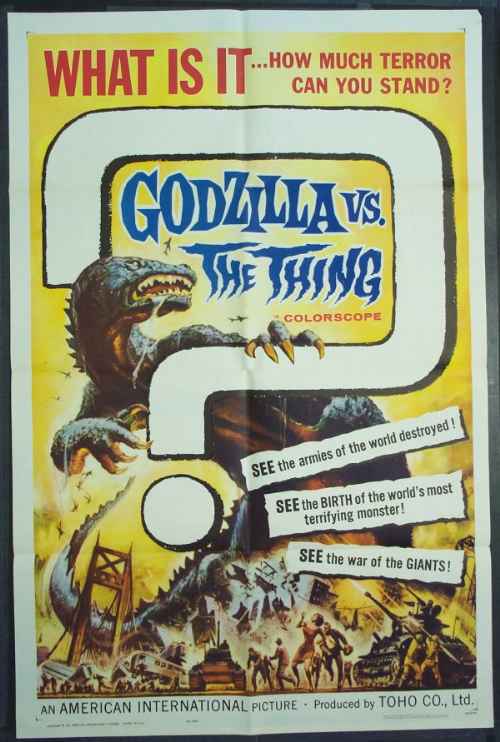 Among fans and critics, this is generally considered the best Godzilla sequel from the original series of films, which ran from GOJIRA in 1954 to TERROR OF MECHA-GODZILLA IN 1975. (The monster was revived for two subsequent series, beginning in 1984 and 2000, respectively, plus the 1998 American film produced at TriStar.) MOTHRA VS. GODZILLA shows the Toho team (director Ishiro Honda, writer Shinichi Sekizawa, composer Akira Ifukube, and effects expert Eiji Tsuburaya) working in top form. Although the dark and serious tone of the original GOJIRA is long gone, the series had yet to descend into the juvenile antics of the 1970s. Only occasional penny pinching (fewer composite shots and elaborate miniatures) and a handful of minor gaffs mar this colorful, elaborate fantasy film, which is thoroughly enjoyable for fans and children, and might even impress a few non-fans.
Among fans and critics, this is generally considered the best Godzilla sequel from the original series of films, which ran from GOJIRA in 1954 to TERROR OF MECHA-GODZILLA IN 1975. (The monster was revived for two subsequent series, beginning in 1984 and 2000, respectively, plus the 1998 American film produced at TriStar.) MOTHRA VS. GODZILLA shows the Toho team (director Ishiro Honda, writer Shinichi Sekizawa, composer Akira Ifukube, and effects expert Eiji Tsuburaya) working in top form. Although the dark and serious tone of the original GOJIRA is long gone, the series had yet to descend into the juvenile antics of the 1970s. Only occasional penny pinching (fewer composite shots and elaborate miniatures) and a handful of minor gaffs mar this colorful, elaborate fantasy film, which is thoroughly enjoyable for fans and children, and might even impress a few non-fans.
The story follows a reporter, Ichiro (Takarada), and his female photographer Nakanishi (Hoshi), who are covering a story about a giant egg that washed ashore after a typhoon. A greedy businessman buys the egg from the local fisherman and, along with his investment partner, plans to build a theme park around it. The Shobijin (twin fairies from Infant Island, home of Mothra) arrive and ask for the return of the egg; the reporters, along with a sympathetic scientist (Koizumi) try to help, but they are unable to persuade the egg’s new owners to relinquish their legal rights in favor of doing the right thing.
Unfortunately, it turns out that Godzilla was also washed ashore by the typhoon; the monster arises from the sandy plain where he was buried and goes on a rampage. The reporters and the scientist head to Infant Island to beg the natives for Mothra’s help. The natives and the Shobijin, whose island was decimated by nuclear testing, are unsympathetic; after all, the so-called civilized world did not help them in their quest to return the egg. The men are ready to give up, but Nakashina makes a heart-felt, emotional plea, which convinces Mothra to join the fight. The giant moth dies in the battle with Godzilla but manages to protect her egg, which hatches not one but two young larvae. The greedy businessmen die while fighting each other in a hotel, which Godzilla trashes. The larvae pursue Godzilla to an island close off shore, where they cocoon him in their sticky web until he falls off a cliff, disappearing beneath the ocean.
MOTHRA VS. GODZILLA is a virtual remake of 1963’s KING KONG VS. GODZILLA: In both films, Godzilla is a radioactive monster threatening Japan, and his opponent is an over-sized animal living on a South Seas island where the natives revere him/her as a god. Both films feature island natives distinguished by their strange skin color (green in the previous film, orange here). Both films feature none-too-subtle attacks on corporate greed that puts profits ahead of morality. And both films end with Godzilla defeated by his foe, falling off a cliff and disappearing beneath the ocean (until the next film, of course).
The chief difference between KING KONG VS. GODZILLA and MOTHRA VS. GODZILLA is that the previous film was a deliberate satire that poked fun at its corporate villains and played its monster battle for laughs, including much anthropomorphized wrestling action. MOTHRA VS. GODZILLA, on the other hand, features some comic relief but generally plays its story straight, and the monster action remains mostly animalistic in nature, avoiding the jump-kicks, somersaults, and back-flips performed by Kong and Godzilla.
Thanks to her colorful wings and graceful movements, Mothra creates a wonderful visual contrast to Godzilla’s scaly reptilian appearance, making her perhaps the best foe ever to square off against the nuclear monster. MOTHRA VS GODZILLA lacks the gravitas of the original GOJIRA; this is not a believable science-fiction story but an imaginative fantasy that requires a suspension of disbelief. Taken on its own terms, it works wonderfully well, even though it’s well past the time when Godzilla could frighten an audience as a walking metaphor for nuclear destruction and the horrors of war.
The result is fast-paced, exciting fun. The film is even moving, when Nakanishi begs the Infant islanders for help in spite of the wrongs they have suffered. The human cast take their roles seriously; the script delivers its message clearly (that humanity should work together for a better world) without being heavy-handed. The elaborate production, with its large cast, numerous locations, and extensive sets, is wonderfully helmed by Honda. And the special effects, though not always convincing, are beautifully done and always entertaining to watch.
MEMORABLE MOMENTS
In one of the greatest scenes in the series, a coordinated military attack strikes Godzilla with canon blast from the ground and napalm bombs from above. When the smoke clears, we see Godzilla with his head thrown back, roaring; as he lowers his face, it suddenly becomes clear that the top and back of his head is on fire! Amazingly, the shot continues a moment longer as Godzilla turns and strides away; it’s hard to believe that half a dozen crew people did not immediately rush into the shot with fire extinguishers instead of allowing suit-actor Haruo Nakajima to continue with the action.
GOOFS
Just before Godzilla leaves shore for the showdown with the Mothra caterpillars, there is a long shot of Godzilla striding along a miniature shoreline that we assume to be on the mainland. Moments later, after Godzilla has crossed the water to a nearby island, the same miniature shoreline is used to represent the island. Clearly, the miniature was built to represent the island. For some reason, the editor took a brief trim from this footage and used it to augment Godzilla’s appearance on the mainland, which otherwise consisted of live-action shots of actual locations, with Godzilla optically inserted into the background.
TRIVIA
The Godzilla suit for this film is one of the favorites among fans. It is lighter and less bulky, allowing for greater movement. The face loses some of the reptilian features from Godzilla’s previous appearances, in which he somewhat resembled a T-Rex mutated by atomic radiation. Its furrowed brows convey a sinister appearance, suggesting a bit more malevolent intent (as opposed to animal instinct) that helps contrast Godzilla with the benign Mothra.
This version of the Godzilla suit is also memorable for another reason: apparently through some kind of accident, the top jaw came loose during filming; it can be seen wobbling during Godzilla’s early scenes. Although an accident, this actually lends a bit of animation to Godzilla’s usually expressionless face.
As with the previous films in the series, a hand-puppet head was used for some close-ups of Godzilla. Typically, the close-up head does not completely match the head worn by Haruo Nakajima, the actor inside the rubber suit.
For some long shots of Godzilla crossing the ocean to a small island, the old suit from KING KONG VS. GODZILLA was used. The suit was also used for the shot of Godzilla, covered in Mothra’s web, tumbling over a cliff and into the ocean for the conclusion. This was done to avoid wear and tear on the new suit, as past experience had shown that the foam rubber Godzilla suit did not hold up well in water.
Although the flying moth puppet from MOTHRA (1961) was reused for some shots, new puppets were built for Mothra in moth and larvae form. This was because the original puppets were created in a different scale and would not have appeared the correct size if photographed in the same shot with the Godzilla suit.
There is less building-bashing in MOTHRA VS. GODZILLA than in previous films. In an effort to keep the budget down, Godzilla briefly attacks a city after his first appearance, then heads to rural areas for most of the rest of the movie. His fight with Mothra in moth form takes place near a sandy beach; his fight with the larvae takes place on a rocky island.
The original title is “Mosura tai Gojira,” which translates as “Mothra versus Godzilla.” The U.S. distributor, American International Pictures, retitled the film “Godzilla Vs. The Thing” and mounted an advertising campaign to create a mystery regarding exactly what sort of foe Godzilla would fight. To justifying the title, the English dubbing includes a few lines of dialogue in which “Shobijin” (small fairies played by identical twins Emi and Yumi Ito) refer to Mothra as “The Mighty Thing.”
This is the only Godzilla film that contains more footage of Godzilla in the export version than in the Japanese original: the English-dubbed U.S. prints contain an early sequence in which the American navy attacks Godzilla on the beach with “Frontier” missiles, knocking the monster down but not killing him. Exactly why this scene is in the American verson but not the Japanese version has never been definitely explained. A common assumption is that the sequence was added to please U.S. distributor, but according to author Steve Ryfle (Japan’s Favorite Mon-Star), the scene existed in the original script, even before a U.S. distribution deal was signed. What is clear is that the Frontier missile sequence was not simply cut out from Japanese prints and retained in U.S. prints: two versions were filmed of the scene that immediately precedes the Frontier missile attack. In the Japanese version, a group of officials sit around a table discussing strategy, and a messenger arrives to report on Godzilla’s movements; this is followed by a shot of Godzilla walking through a hilly area, suggesting that he is moving away from the city. In the American version, the shot of Godzilla appears immediately after his first attack on a city; then the film cuts to the strategy meeting, with a slightly different group of officials, including a handful of Americans, sitting around the same table and discussing plans to use the new missiles. The fact that two versions of this scene were filmed suggests that there was a deliberate attempt to create an “alternate” version for U.S. consumption.
Emi and Yumi Ito were well known in their native land as the singing duo The Peanuts. Here, they sing both the “Mothra” song composed by Yuji Koseki for MOTHRA (1961), plus a “Lament for Infant Island” composed for this film by Akira Ifukube.Despite a few minor editorial changes (the addition of the Frontier missile sequence, the deletion of a shot of one villain with a bloody head after being gunned down by his partner), the Americanized GODZILLA VS THE THING remains mostly faithful to the Japanese original. In fact, this is the first Godzilla film to reach U.S. shores without major alterations: there is no new footage added by the American distributor; the dubbing retains most of the story and dialogue, and Akira Ifukube’s score is left intact (except for a brief edit to the Shobijin’s lament for Infant Island).
DVD DETAILS
In the U.S., GODZILLA VS. THE THING has been released several times on VHS, laserdisc, and DVD (often with title on the box art changed to “Godzilla vs. Mothra”). Perhaps because this film was not heavily altered for U.S. release, there was less urgency from fans for obtaining a DVD that restored the original version, complete with Japanese language and English subtitles.
The Toho Master Collection DVD , released in the U.S. by Classic Media in 2007, includes both the Japanese-language MOTHRA VS. GODZILLA (with optional subtitles) and the Americanized GODZILLA VS. THE THING (with optional audio commentary). The disc comes in a silver slipcase that resembles a small book. The front cover features colorful poster artwork from the Japanese release; the back has three color images from the film; and the interior includes a black-and-white publicity photo that composites Mothra flying over Godzilla, who is waist deep in the ocean, to create a scene that does not appear in the film. Bonus features include an audio commentary, a poster slideshow, and a biography of Akira Ifukube.
The DVD menu features a collage of poster art from the film. The American and the Japanese version are each divided into 11 chapters, accessible from nearly identical menus: Both versions display the “Godzilla vs. the Thing” title card for the first chapter. However, Chapter 6 of GODZILLA VS THE THING, which begins with the alternate scene that introduces the Frontier missile sequence, is titled “Send in the Fleet.” Chapter 6 of MOTHRA VS. GODZILLA, which begins with a different version of the scene and omits the Frontier missile sequence, is titled “Military Orders.”
The slideshow features fifteen advertising images, backed by audio from the opening credits (including the main title music and the typhoon sound effects). One lobby card, from a 1980 reissue of the movie, features the anachronistic image of the goofy-looking Godzilla suit first seen in 1974’s GODZILLA VS. MECHA-GODZILLA.
The Ifukube biography consists of text that provides a brief rundown of the symphonic composer’s career, emphasizing his work on science-fiction film scores. It ends with a moving tribute from producer Shogo Tomiyama, who worked with Ifukube on Godzilla films in the 1990s.
The audio commentary by Steve Ryfle and Ed Godziszewski is insightful and informative. The duo discuss the changes made to the film for U.S. release, praise the dubbing, point out the film’s message, and offer up interesting tidbits about the techniques used to bring Godzilla and Mothra to life (e.g., special effects director Eiji Tsuburaya talked Toho Studios into purchasing an optical printer, a device that facilitated combining live-action with miniatures, in order to create smoother composite shots of Godzilla appearing above the real city skylines).
Although fans, Ryfle and Godziszewski are willing to point out flaws, such as the high-speed photography that makes Mothra’s wings beat fast enough to show her take flight – but which also makes Godzilla tumble over like a silent movie comedian. They criticize the artificial look of the Infant Island exteriors and report that director Ishiro Honda regretted not fighting for more elaborate island sets. Ryfle also notes that the story is mostly wrapped up by the time the larvae hatch from Mothra’s egg, so the screenplay is forced to gin up a crisis (some school kids left on an island in Godzilla’s path) to fill up the final reel.
If there is a problem with the commentary it is that the word “realistic” crops up too often in regards to the effects work. By this point in the Godzilla series, it is clear that there was less effort to make the monsters look big and convincing on screen; the scenes of Godzilla battling Mothra or miniatures tanks and airplanes are always exciting and eye-catching, but they are seldom truly convincing.
With all this, the Toho Masters DVD might sound like a must-have item for your collection; unfortunately, the disc falls short in one significant way: image quality. The American print is decent but slightly soft, with colors a tad faded, plus some noticeable scratches and speckling. The Japanese print is better, with a somewhat sharper image and less visible speckling.
The big problem is not colors or scratches but letterboxing, which does not do justice to the widescreen compositions of the original theatrical presentation. MOTHRA VS GODZILLA was shot in a 2.35 anamorphic process that filled the movie screen with special effects, action, beautiful locations, and elaborate sets – some of which are cut off on the DVD.
The American print is framed at approximately a 1.85 aspect ratio that omits large sections of the picture from the left and the right. This problem is most obvious during Godzilla’s brief raid on a metropolitan center. In one elaborate long shot, the camera pans from right to left across a crowd of fleeing people to reveal Godzilla in the far left background – except that he remains off-screen in this version, thanks to cropping off of the edges of the frame.
The Japanese print is considerably better but not perfect. The aspect ratio approximates the theatrical version, with only a minimal loss of picture information on the left and right. In the shot mentioned above, sharp-eyed viewers can catch a glimpse of Godzilla nosing his way into the left side of the frame just before the camera cuts away to another scene.
In this regard, the Toho Masters Collection DVD is inferior to the 1990s Scimitar DVD release of GODZILLA VS MOTHRA, which actually featured a widescreen and a full screen transfer of the English-dubbed GODZILLA VS THE THING.
The widescreen Scimitar transfer framed the image in the correct 2.35 aspect ratio. The print was perhaps darker and grainier, but the speckling was less obvious (except during composite photography). Although far from perfect, the Scimitar version presented the full image to the viewer, so that Godzilla’s dramatic entrance into the panning special effects shot in question was plainly visible.
Because of incorrect letter-boxing, the Toho Masters Collection DVD cannot be considered an adequate replacement for the out-of-print Scimitar DVD. The Toho Masters disc is essential for American fans who want to obtain the Japanese version of MOTHRA VS. GODZILLA on DVD. The bonus features make it a nice addition to the collection of any G-Fan, even those who prefer the English-dubbed GODZILLA VS. THE THING. But cropped image transfer prevents this disc from being reckoned as the definitive DVD presentation of one of Toho’s most highly regarded classic monster movies.
 MOTHRA VS. GODZILLA (Mosura Tai Gojira, a.k.a. “Godzilla vs. The Thing,” 1964). Produced by Tomoyuki Tanaka. Directed by Ishiro Honda. Written by Shinichi Sekizawa. Cast: Akira Takarada, Yuriko Hoshi, Hiroshi Koizumi, Yu Fujiki, The Peanuts (Emi and Yumi Ito), Yoshifumi Tajima, Kenji Sahara, Jun Tazaki, Kenzo Tabu, Haruo Nakajima.
MOTHRA VS. GODZILLA (Mosura Tai Gojira, a.k.a. “Godzilla vs. The Thing,” 1964). Produced by Tomoyuki Tanaka. Directed by Ishiro Honda. Written by Shinichi Sekizawa. Cast: Akira Takarada, Yuriko Hoshi, Hiroshi Koizumi, Yu Fujiki, The Peanuts (Emi and Yumi Ito), Yoshifumi Tajima, Kenji Sahara, Jun Tazaki, Kenzo Tabu, Haruo Nakajima.
RELATED ARTICLES:
Godzilla: Final Wars (2004) – Review
This 50th anniversary grand finale to the long-running series is a rush of explosive excitement that pays homage to what came before but hypes it up into a kinetic brew that feels fresh and exciting — not an obituary-like coda but a glorious send-off. Director Kitamura brings a modern sensibility and fast-paced, unrelenting energy to the screen, with almost literally non-stop action.
Like many Godzilla films from the 1990s on, this one combines many familiar elements, some from older Godzila films, some from popular American films. Bits from Toho efforts like GORATH and ATRAGON pop up. And without looking too hard, you’ll see elements of THE MATRIX and X-MEN, along with scenes reminiscent of everything from STAR WARS to STAR TREK to ALIEN. Of course, the world-wide alien-invasion plot sounds suspiciously similar to INDEPENDENCE DAY, but then ID4 bore obvious structural similarities to DESTROY ALL MONSTERS, the well-loved 1968 monster fest about aliens invading Earth.
In fact, FINAL WARS is essentially a remake of DESTROY ALL MONSTERS (dozens of monsters, controlled by aliens, decimated the Earth until Godzilla emerges to save the day). The film benefits from audience familiarity by simply throwing viewers into the middle of things and expecting them to sort it out: each monster is given at most a brief introduction, with little exposition to explain its existence. This allows the film to race through the projector like an unstoppable bullet train, piling one big scene upon the next.
The film evokes the special effects stylings and more serious approach of the recent Toho films, with Godzilla cast as a sort of dangerous anti-hero not because he likes humanity but because he hates intruders pushing into his territory. But FINAL WARS also harkens back to the colorfully entertaining (if frequently ridiculous) ’60s G-flicks, wherein an anthropomorphised, heroic Godzilla wrestled with his foes to the delight of fans who enjoyed the spectacle even though it undermined credibility.
The special effects are mostly on par with Toho’s previous “Millennium Series” G-films (i.e., those made after the atrocious 1998 American GODZILLA). The miniatures are elaborate and impressive, if not always convincing. The monsters are still men in suits, but the suits are detailed and capable of greater movement and expression. Also, instead of simply using slow-motion to give a sense of scale to the suit-mation, computer-generated imagery enhances the scenes, creating motion blur that gives a greater sense of large objects moving at a powerfully fast speed.
The new Godzilla suit somewhat resembles the look first introduced in GODZILLA 2000, combined with some elements from the earlier 1990s suit. It is also lighter and more upright, moving away from the slouching reptilian walk and returning somewhat to the humanoid swagger of DESTROY ALL MONSTERS, allowing for more fast-paced hand-to-hand combat.
Kitamura takes a modern approach to these battle scenes – both the monsters and the humans, with lots of fancy camera angles and over-the-top stunts. In one amusing scene, he even makes the parallel explicity clear when our hero in the foreground is beating up the villain, while in the background Godzilla is fighting a monster on a video screen – and both fights are perfectly synchronized.
Perhaps the best and briefest battle occurs between Godzilla (the familiar Japanese Godzilla, that is) and the infamous Godzilla-In-Name-Only (i.e., the giant iguana from the awful 1998 American film). The classic Godzilla easily dispatches his would-be replacement, while the disappointed alien villain grumbles, “I knew that tuna-eating monster was useless.”
The scene works on a meta-level, with the traditional man-in-a-suit monster vanquishing his CGI-spawned namesake. Ironically, the CGI ‘Zilla (so called to distinguish him from the real Godzilla) is rendered much more effectively here than he was in the American film. In other cases, however, the CGI is not up to such high standards. For example, an early attack by the sea snake Manda is about on the level of a videogame. This is doubly disappointing because the monster looks good at first — when it is realized with a well-manipulated marionette.
The lightening-paced, no-time-to-stop-and-think approach to the film is underscored by great soundtrack music, featuring contributions from prog-rocker Keith Emerson. Most of the nearly wall-to-wall score has a quick-tempo, techno-industrial sound that makes it feel almost as if you are watching a dozen music videos strung one after the other. Only during the closing credits, underscored by a rousing fanfare, does the more familiar Emerson sound emerge, with a catchy organ-riff beneath the synthesized orchestral swells.
As for the human characters, the performers are almost universally engaging and likable. In the Neo role (he turns out to be a “Kaiser,” more or less the same thing as being “The One”), Masahiro Matsuoka is an entertaining Asian equivalent of Keanu Reeves. Special mention should be awarded to the alien villain for his over-the-top temper tantrums every time one of his monsters loses a battle with Godzilla. Even Don Frye, a martial arts instructor, looks properly rough and tough for his role as Captain Gordon; although obviously not a professional actor, he can growl “son-of-a-bitch” really well when something goes wrong.
The overall tone of GODZILLA: FINAL WARS is dark and tense and grim, seemingly geared to the key target demographic: young adult audiences eager for action-packed entertainment. Although surrounded by a supporting cast of famliar character actors (including Akira Takarada, whose career stretches all the way back to the original GODZILLA), the leads are young, glamorous types obviously meant to lend a little sex appeal. (You expect the television interviewer to look good, but even her sister, the lady biologist, usually finds a way to pose so that her skirt shows off her legs to good advantage.)
Despite this appeal to viewers in their teens and twenties, some elements – a bit jarringly – are included to reach the kiddie audience that loves Godzilla too. In particular, the younger Godzilla (here called Minilla) looks just as goofy and cute as he did back in the 1960s, and his scenes almost seem dropped in from another movie, or like second-unit stuff inserted at the insistence of the studio. (On the other hand, these comic relief episodes do provide welcome respite from the breathless pace of the rest of the movie.)
These brief missteps are not enough to undermine the film, which is a pulse-pulverizing bit of special effects and martial arts mayhem that truly is good enough to deserve a stateside release. Certainly, the film is over-the-top and utterly fantastic, and it doesn’t provide dramatic closure for the series the way that GODZILLA VS. DESTROYER did in 1995. But even at its worst it is nowhere near as silly as the dreary and unexciting SKY CAPTAIN AND THE WORLD OF TOMORROW. If Hollywood thought that film was worthy of a nationwide release, it is a shame they did not give GODZILLA: FINAL WARS the same opportunity.
GODZILLA: FINAL WARS (Toho, 2004). Directed by Ryuhei Kitamura. Written by Kitamura & Isao Kiriyama, from a story by Wataru Mimura & Shogo Tomiyama. Cast: Masahiro Matsuoka, Rei Kikukawa, Akira Takarada, Kane Kosugi, Kazuki Kitamura, Maki Mizuno, Don Frye.
